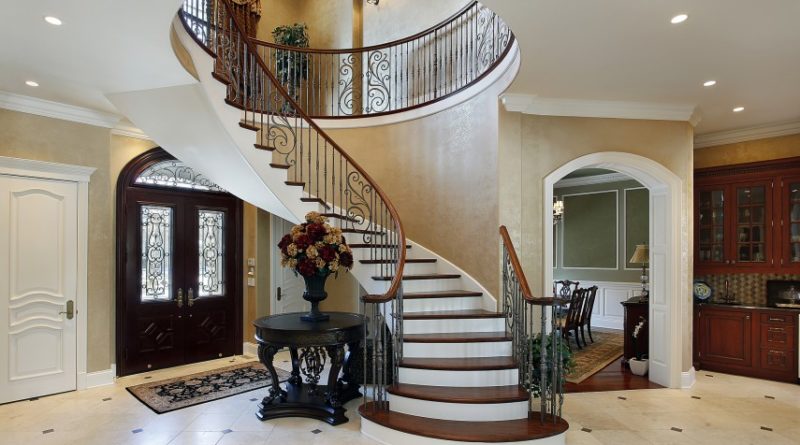CURVED STAIRCASE | An Architect Explains
Curved Stairs are stairs which curve in plan. The treads in such stairs are wedge-shaped, tapering at one end. Curved stairs are elegant and graceful in appearance and for this reason, the most desired in houses.

There are different types of curved stairs possible. They have both advantages and disadvantages. To help you decide which type of staircase is best suited for you, as an Architect, I have explained the different types of curved stairs here under the following headings:
What are the advantages of curved staircases?
What are the disadvantages of curved staircases?
What are the different types of curved staircases?
Advantages of Curved stairs:
Sophistication: A curved staircase will add a level of luxury to the entrance way of any home.
Resale value: It also increases a home’s resale value and so is a great investment.
Conform to space: Curved stairs have the major advantage that they can be twisted and turned and curved to fit any configuration of a room.
Take up less space: They don’t take up the same amount of room as a regular staircase.
Disadvantages of Curved stairs:
Custom built: All aspects of the stairs have to be custom designed and built by professionals.
Specialised skill is needed for building all basic details, the winder steps, the curved stringers, the curved handrails etc.
Internal support: A free-standing curved staircase has to be strong enough to support itself and requires a lot of internal support.
Steep: Since curved stairs take up lesser space than regular stairs, they’re steeper and difficult to use, especially by the elderly.
Dizzy: The circular movement as one climbs or descends can make some people dizzy.
Expensive: They are very expensive since they are very difficult-to-make.

WHAT ARE THE DIFFERENT TYPES OF CURVED STAIRS?
Arched Stairs: Arched Stairs are stairs with a flight resembling an arch in its shape like the one shown here. Arched stairs require skill to manufacture and are expensive. But they are definitely a good investment as they create a good impression.

Spiral Stairs: Stairs of this type appear like a circle or part of it, with a central vertical post constituting the backup abutment for all treads in the flight. Here, just like in Arched Stairs the treads are wedge-shaped, and uniform-sized. Due to their spiral shape such staircases fit into almost any small space. However, such staircases are not convenient for frequent use, in view of fast climbing up a confined area.

Circular Stairs: A circular staircase also resembles a circle in plan and fit into a small space. The steps wind similar to a spiral staircase, but there is no support pole in the middle. A circular staircase may have a very narrow diameter like the one seen in this picture or a wide curve giving it a very grand appearance.

Elliptical Stairs: This is a type of curved staircase that narrows at the top and bottom with a wider curve in the middle. It resembles an elliptical shape in plan like the one shown here.The stairs shown in this post are just a few examples. Innumerable types are possible with the imaginative use of different materials for the treads, risers, stringers, balusters and railings.

However, curved stairs have to be custom-built and require specialised skill. Therefore they are very expensive. Cheaper options are Straight stairs or Straight stairs with landings.
Related topics:
If you found this post useful, all it takes is a simple click on the “pin it” “like,” “share,” “tweet,” or Google+ buttons below the post. Thank you!




